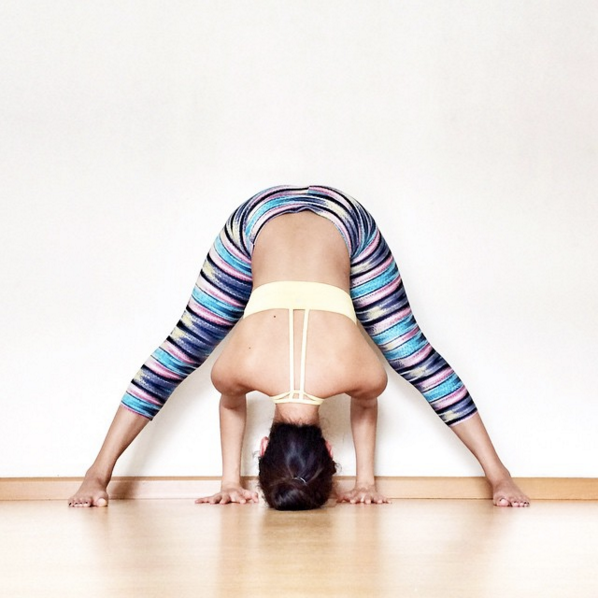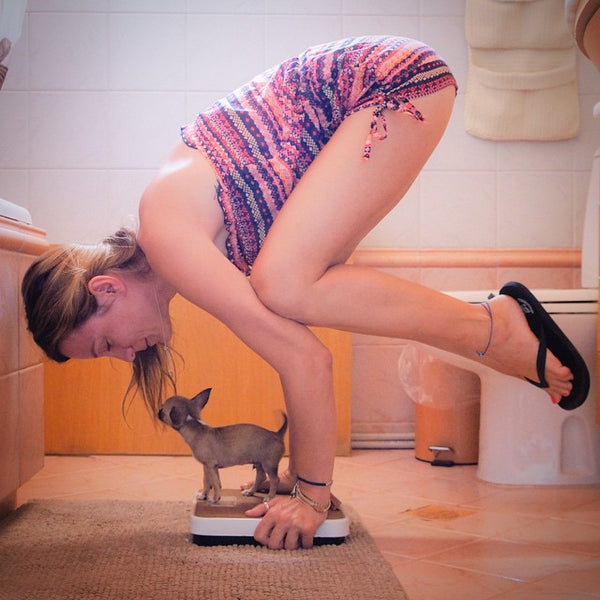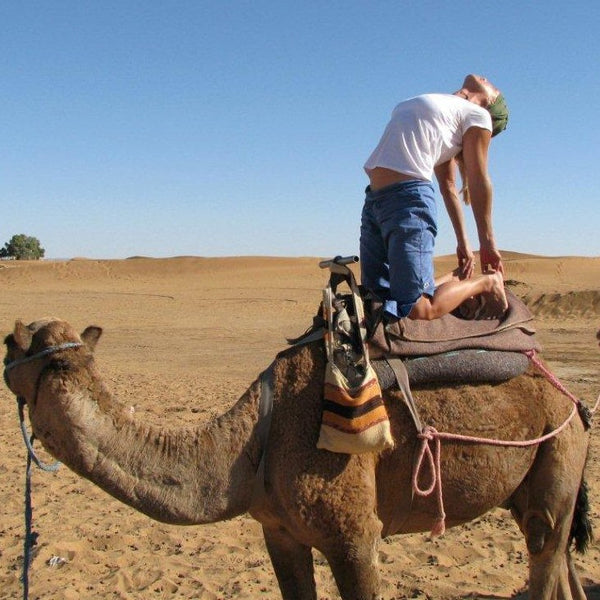Mula Bandha Check-Up - 11 Tips to Master the Yoga Lift
Have you ever been asked to do a Mula Bandha check-up in a yoga lesson? Perhaps the following questions popped into your head: What on earth is a Mula Bandha and how do I check it up? Don't worry, we've got your back. [caption id="attachment_21392" align="alignnone" width="585"] Mula Bandha check-up by Erika Contreras via instagram.com/erikacv[/caption]
Mula Bandha check-up by Erika Contreras via instagram.com/erikacv[/caption]
 The most common Mula Bandha check-up is to sit on the floor with the legs open at around 60-70 degrees. Place one hand in between the legs on the floor and the other on the outside of the thigh, and press down with the arms and lift up with the body, keeping the legs straight.
The most common Mula Bandha check-up is to sit on the floor with the legs open at around 60-70 degrees. Place one hand in between the legs on the floor and the other on the outside of the thigh, and press down with the arms and lift up with the body, keeping the legs straight.
 Lifting up with straight legs is the next most popular check-up. Place the hands on the floor a little lower than the hips, around mid-thigh level.
Lifting up with straight legs is the next most popular check-up. Place the hands on the floor a little lower than the hips, around mid-thigh level.
 Practicing the check-up by only lifting one leg up at a time is a great way to build strength and work your way into a lift up.
Practicing the check-up by only lifting one leg up at a time is a great way to build strength and work your way into a lift up.
 Try the traditional way of doing a Mula Bandha check-up but on a step to slowly practice building up the space between the feet and the floor.
Try the traditional way of doing a Mula Bandha check-up but on a step to slowly practice building up the space between the feet and the floor.
 Another good way to check your Mula Bandha is while sitting on the knees. Since this tends to make the upper body taller hence creating the illusion of shorter arms, leaning on the fists can help give the arms more length. Also, the wrists might get sore after many check-ups so using the fists is a great way to give the wrists a bit of a break.
Another good way to check your Mula Bandha is while sitting on the knees. Since this tends to make the upper body taller hence creating the illusion of shorter arms, leaning on the fists can help give the arms more length. Also, the wrists might get sore after many check-ups so using the fists is a great way to give the wrists a bit of a break.
 This is a nice way to cheat if you so wish (but you wouldn't want to do that... would you?) as you can lean the legs on the arms to help with the lift up. Just saying...
This is a nice way to cheat if you so wish (but you wouldn't want to do that... would you?) as you can lean the legs on the arms to help with the lift up. Just saying...
 If you feel that you will never get off the floor, think again. Get some blocks under those knees and get that bum off the floor. Put the hands on the floor next to each thigh to get used to the positioning of the body (to prove that your arms are not "too short").
If you feel that you will never get off the floor, think again. Get some blocks under those knees and get that bum off the floor. Put the hands on the floor next to each thigh to get used to the positioning of the body (to prove that your arms are not "too short").
 Sitting crossed-legged with the arms on the floor or on blocks and managing to lift only your bottom off the floor while keeping the feet on the floor and engaging the Mula Bandha, is a good a check-up as any.
Sitting crossed-legged with the arms on the floor or on blocks and managing to lift only your bottom off the floor while keeping the feet on the floor and engaging the Mula Bandha, is a good a check-up as any.
 This pose is Kukkutasana (Rooster Pose). It's a Mula Bandha check-up performed by shoving your arms through your Lotus holes! In Ashtanga, it's common for practitioners to have spray bottles of water with them to make their Lotus holes slippery as getting the arms through there can prove a bit difficult (and you wouldn't want to get stuck like this). So now you should be ready to do a full Mula Bandha check-up like Sofia Xirotiri here... https://instagram.com/p/1djtmjwiYq/?taken-by=sofiayoga Or the lovely Ambra Vallo... https://instagram.com/p/2HjctJR5Fy/ If they can do it... Sigh... Do you have any other tips for mastering the Mula Bandha check-up that we haven't covered here? Please share your tips and tricks with us; we'd love to hear from you. And if you are curious about the practice, check out our beginner's guide to Ashtanga yoga. Featured image courtesy of Erika Contreras via instagram.com/erikacv
Or connect with us on social media (facebook, twitter, instagram, pinterest or tumblr).
This pose is Kukkutasana (Rooster Pose). It's a Mula Bandha check-up performed by shoving your arms through your Lotus holes! In Ashtanga, it's common for practitioners to have spray bottles of water with them to make their Lotus holes slippery as getting the arms through there can prove a bit difficult (and you wouldn't want to get stuck like this). So now you should be ready to do a full Mula Bandha check-up like Sofia Xirotiri here... https://instagram.com/p/1djtmjwiYq/?taken-by=sofiayoga Or the lovely Ambra Vallo... https://instagram.com/p/2HjctJR5Fy/ If they can do it... Sigh... Do you have any other tips for mastering the Mula Bandha check-up that we haven't covered here? Please share your tips and tricks with us; we'd love to hear from you. And if you are curious about the practice, check out our beginner's guide to Ashtanga yoga. Featured image courtesy of Erika Contreras via instagram.com/erikacv
Or connect with us on social media (facebook, twitter, instagram, pinterest or tumblr).
 Mula Bandha check-up by Erika Contreras via instagram.com/erikacv[/caption]
Mula Bandha check-up by Erika Contreras via instagram.com/erikacv[/caption]
What is Mula Bandha?
A Bandha is a body energy lock, the most popular being Uddiyana Bandha which we all use on a daily basis. This is our core strength. The feeling of engagement of the muscles when performing abdominal crunches is Uddiyana Bandha being activated. Another energy lock is the Mula Bandha, which is often referred to as the Root Lock:"The root referred to here is the root of the spine, the pelvic floor or, more precisely, the centre of the pelvic floor, the perineum. The perineum is the muscular body between the anus and the genitals. By slightly contracting the pubo-coccygeal (PC) muscle, which goes from the pubic bone to the tail bone (coccyx), we create an energetic seal that locks prana into the body and so prevents it from leaking out at the base of the spine." - Gregor MaehleLegendary late yogi, BKS Iyengar describes the activation of the Mula Bandha as "a posture where the body from the anus to the navel is contracted and lifted up and towards the spine". In this video, Kino MacGregor gives a great explanation of what Mula Bandha is and how to access it. In summary:
- Mula Bandha is engaging the floor muscles and all the muscles in the interior space of the pelvis.
- Benefits: builds strength and more support and flexibility in the hip joints and lower back.
- Activation of the Mula Bandha requires laser beam like precision of mind to focus on the exact spot where the Mula Bandha is which is the space between the tail bone and the pubic bone, and then focusing on the perineum, the space between the genitals and the anus.
- Sri K Pattabhi Jois said that Mula Bandha can be accessed by contracting the anus.
- After contracting the floor of the perineum, focus more intently and contract the genital area; For women: Contracting the opening of the vagina. For men: lifting up the testicles into the body.
How to do a Mula Bandha Check-Up
A Mula Bandha check-up is being able to use the technique of engaging the Mula Bandha to lift the body off the floor using only the arms. In this video, Kino explains the technique behind the Mula Bandha check-up with straight legs. In summary:- The first step is to lift the butt off the ground with the legs straight with the feet still on the floor for support.
- Place the hands on the floor right next to the thighs, and lean forward when lifting up.
- Use the whole body to lift up and don't rely solely on the arms.
- Bend the arms, suck in the lower ribs, flex the spine and activate the core, engage the pelvic floor, inhale and straighten the arms to lift the body off the ground.
- Drag the heels back to get the bottom raised off the floor.
- To get both feet off the ground, keep dragging the feel back. Lean forward with bent arms sucking in the lower ribs, press down and straighten the arms, pull back until both feel come off of the ground.
1. The traditional way
 The most common Mula Bandha check-up is to sit on the floor with the legs open at around 60-70 degrees. Place one hand in between the legs on the floor and the other on the outside of the thigh, and press down with the arms and lift up with the body, keeping the legs straight.
The most common Mula Bandha check-up is to sit on the floor with the legs open at around 60-70 degrees. Place one hand in between the legs on the floor and the other on the outside of the thigh, and press down with the arms and lift up with the body, keeping the legs straight.
2. With straight legs
 Lifting up with straight legs is the next most popular check-up. Place the hands on the floor a little lower than the hips, around mid-thigh level.
Lifting up with straight legs is the next most popular check-up. Place the hands on the floor a little lower than the hips, around mid-thigh level.
3. With straight legs - one at a time
 Practicing the check-up by only lifting one leg up at a time is a great way to build strength and work your way into a lift up.
Practicing the check-up by only lifting one leg up at a time is a great way to build strength and work your way into a lift up.
4. Tolasana (Scale Pose)
http://instagram.com/p/2EhB4xP-CU/?taken-by=owlkath This check-up is a dedicated yoga pose in itself called Tolasana. Getting your legs into a Lotus has been proven to make a Mula Bandha check-up easier. The lift up becomes a bit easier because you don't really need to do anything with your legs as they are tucked away neatly and out of the way.5. Using a step
 Try the traditional way of doing a Mula Bandha check-up but on a step to slowly practice building up the space between the feet and the floor.
Try the traditional way of doing a Mula Bandha check-up but on a step to slowly practice building up the space between the feet and the floor.
6. Use the fists
 Another good way to check your Mula Bandha is while sitting on the knees. Since this tends to make the upper body taller hence creating the illusion of shorter arms, leaning on the fists can help give the arms more length. Also, the wrists might get sore after many check-ups so using the fists is a great way to give the wrists a bit of a break.
Another good way to check your Mula Bandha is while sitting on the knees. Since this tends to make the upper body taller hence creating the illusion of shorter arms, leaning on the fists can help give the arms more length. Also, the wrists might get sore after many check-ups so using the fists is a great way to give the wrists a bit of a break.
7. Using yoga blocks
http://instagram.com/p/ut3akdwnLv/?taken-by=rissawray One of the main complains people have with Mula Bandha check-ups is thinking that their arms are too short. The trick is to suck in the lower ribs and make the upper body as small as possible before lifting up. Using yoga blocks is a great way to practice this move and give the arms those extra inches.8. Legs around the arms
 This is a nice way to cheat if you so wish (but you wouldn't want to do that... would you?) as you can lean the legs on the arms to help with the lift up. Just saying...
This is a nice way to cheat if you so wish (but you wouldn't want to do that... would you?) as you can lean the legs on the arms to help with the lift up. Just saying...
9. Blocks under the knees
 If you feel that you will never get off the floor, think again. Get some blocks under those knees and get that bum off the floor. Put the hands on the floor next to each thigh to get used to the positioning of the body (to prove that your arms are not "too short").
If you feel that you will never get off the floor, think again. Get some blocks under those knees and get that bum off the floor. Put the hands on the floor next to each thigh to get used to the positioning of the body (to prove that your arms are not "too short").
10. Keep the feet on the floor
 Sitting crossed-legged with the arms on the floor or on blocks and managing to lift only your bottom off the floor while keeping the feet on the floor and engaging the Mula Bandha, is a good a check-up as any.
Sitting crossed-legged with the arms on the floor or on blocks and managing to lift only your bottom off the floor while keeping the feet on the floor and engaging the Mula Bandha, is a good a check-up as any.
11. Through the lotus holes
 This pose is Kukkutasana (Rooster Pose). It's a Mula Bandha check-up performed by shoving your arms through your Lotus holes! In Ashtanga, it's common for practitioners to have spray bottles of water with them to make their Lotus holes slippery as getting the arms through there can prove a bit difficult (and you wouldn't want to get stuck like this). So now you should be ready to do a full Mula Bandha check-up like Sofia Xirotiri here... https://instagram.com/p/1djtmjwiYq/?taken-by=sofiayoga Or the lovely Ambra Vallo... https://instagram.com/p/2HjctJR5Fy/ If they can do it... Sigh... Do you have any other tips for mastering the Mula Bandha check-up that we haven't covered here? Please share your tips and tricks with us; we'd love to hear from you. And if you are curious about the practice, check out our beginner's guide to Ashtanga yoga. Featured image courtesy of Erika Contreras via instagram.com/erikacv
This pose is Kukkutasana (Rooster Pose). It's a Mula Bandha check-up performed by shoving your arms through your Lotus holes! In Ashtanga, it's common for practitioners to have spray bottles of water with them to make their Lotus holes slippery as getting the arms through there can prove a bit difficult (and you wouldn't want to get stuck like this). So now you should be ready to do a full Mula Bandha check-up like Sofia Xirotiri here... https://instagram.com/p/1djtmjwiYq/?taken-by=sofiayoga Or the lovely Ambra Vallo... https://instagram.com/p/2HjctJR5Fy/ If they can do it... Sigh... Do you have any other tips for mastering the Mula Bandha check-up that we haven't covered here? Please share your tips and tricks with us; we'd love to hear from you. And if you are curious about the practice, check out our beginner's guide to Ashtanga yoga. Featured image courtesy of Erika Contreras via instagram.com/erikacv
Follow us for more free, high-quality yoga and mindfulness content... and subscribe to our mailing list below!
Also in Yoga Poses

Prasarita Padottanasana - Love Your Wide-Legged Forward Bend
Prasarita Padottanasana or Wide Legged Forward Bend is one of the most loved yoga poses from the yoga standing sequence. Here's all you need to know.


